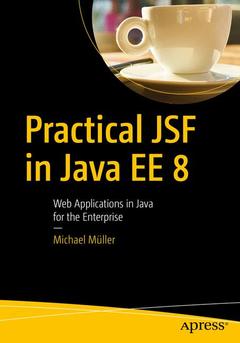Description
Practical JSF in Java EE 8, 1st ed.
Web Applications in Java for the Enterprise
Language: English
Subject for Practical JSF in Java EE 8:
Keywords
Web; development; Java; Java EE; JSF; Java Server Faces; JavaServer Faces; JSP; JavaServer Pages; Java Server; Servlets; programming; software; code; Java EE 8; examples; case studies; samples; source
Support: Print on demand
Description
/li>Contents
/li>Biography
/li>Comment
/li>
Master the Java EE 8 and JSF (JavaServer Faces) APIs and web framework with this practical, projects-driven guide to web development. This book combines theoretical background with a practical approach by building four real-world applications. By developing these JSF web applications, you'll take a tour through the other Java EE technologies such as JPA, CDI, Security, WebSockets, and more.
In Practical JSF in Java EE 8, you will learn to use the JavaServer Faces web framework in Java EE 8 to easily construct a web-based user interface from a set of reusable components. Next, you add JSF event handling and then link to a database, persist data, and add security and the other bells and whistles that the Java EE 8 platform has to offer.
After reading this book you will have a good foundation in Java-based web development and will have increased your proficiency in sophisticated Java EE 8 web development using the JSF framework.
What You Will Learn
- Use the Java EE 8 and the JavaServer Faces APIs to build Java-based web applications through four practical real-world case studies
- Process user input with JSF and the expression language by building a calculator application
- Persist data using JSF templating and Java Persistence to manage an inventory of books
- Create and manage an alumni database using JSF, Ajax, web services and Java EE 8's security features.
Who This Book Is For
Those new to Java EE 8 and JSF. Some prior experience with Java is recommended.
Michael Müller is an IT professional with more than 30 years of experience including about 25 years in the healthcare sector. During this time, he has worked in different areas, especially project and product management, consulting, and software development. He gained international knowledge not only by targeting international markets, but also by leading external teams (from Eastern Europe and India).
Currently, he is the head of software development at the German DRG institute [http://inek.org]. In this role, he is responsible for Web applications as well as other Java and .NET projects.Web projects are preferably built with Java technologies such as JSF with the help of supporting languages like JavaScript.
Michael is a professional JSF user and a member of the JSR 344 and JSR 372 (JSF) expert groups. Due to his community activities he was invited to join the NetBeans Dream Team and became a member January 2016.




